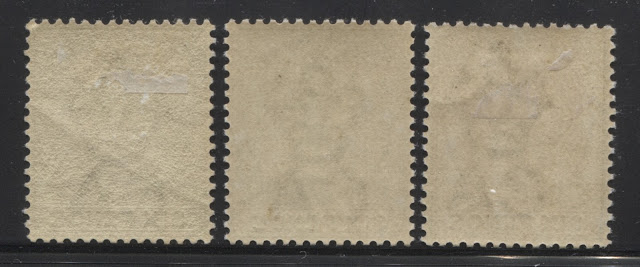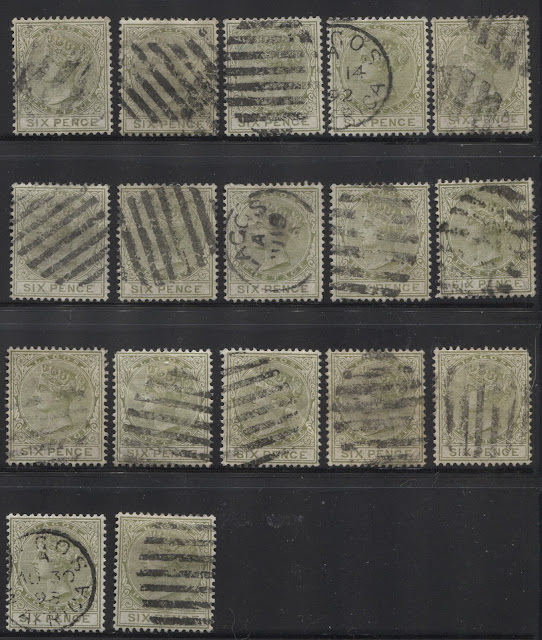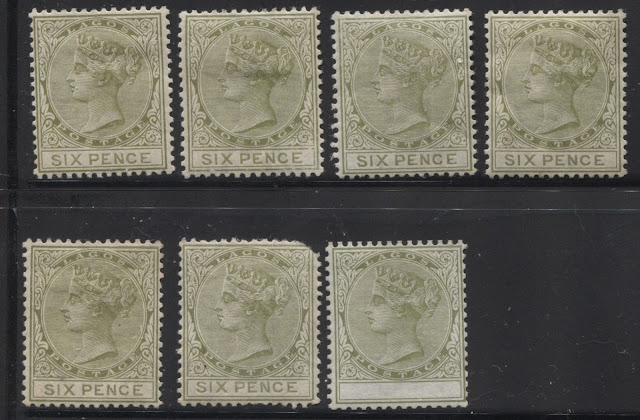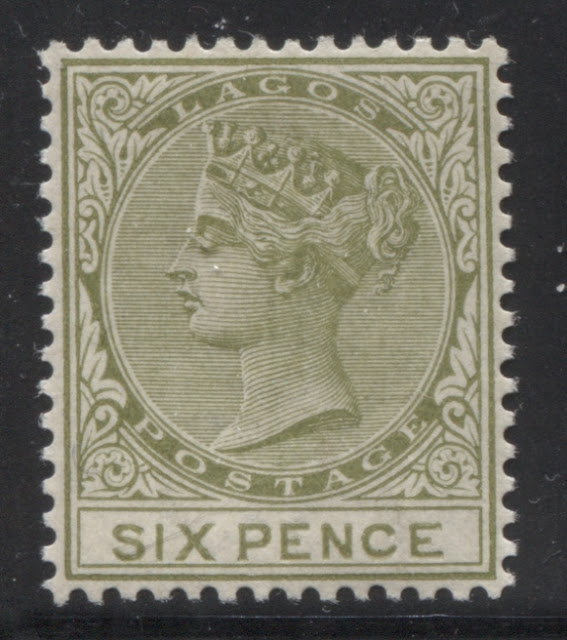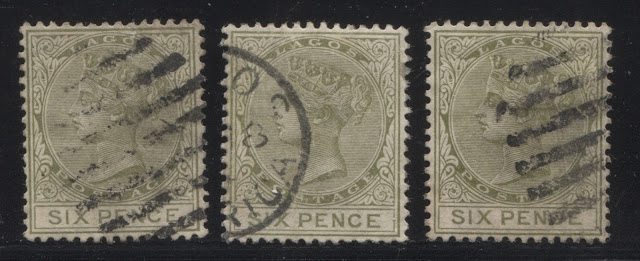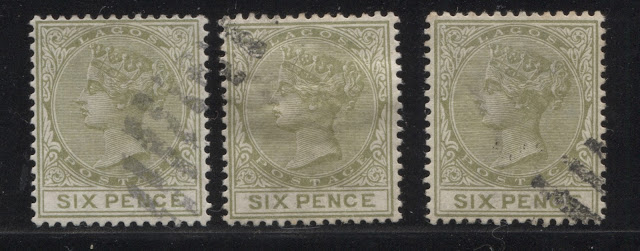Overview
Today's post will pick up where last week's post left off with how to distinguish the six printings of the 6d olive green definitive of Lagos that was in use between 1884 and 1887 when it was replaced by the bi-coloured mauve and claret definitive stamp.
The six printings, which were released at the same time as the 1/- orange, were dispatched as follows:
Today's post will pick up where last week's post left off with how to distinguish the six printings of the 6d olive green definitive of Lagos that was in use between 1884 and 1887 when it was replaced by the bi-coloured mauve and claret definitive stamp.
The six printings, which were released at the same time as the 1/- orange, were dispatched as follows:
- First printing - July 8, 1884 - 58 sheets of 60 stamps - 3,480 stamps.
- Second printing - December 16, 1884 - 62 sheets of 60 stamps - 3,720 stamps.
- Third printing - July 13, 1885 - 60 sheets of 60 stamps - 3,600 stamps.
- Fourth printing - December 29, 1885 - 61 sheets of 60 stamps - 3,660 stamps.
- Fifth printing - June 30, 1886 - 58 sheets of 60 stamps - 3,480 stamps.
- Sixth printing - October 12, 1886 - 76 sheets of 60 stamps - 4,560 stamps.
It will immediately be apparent that the quantities dispatched for each printing were roughly the same, although the last printing had a quantity about 30% higher than the other printings. I would expect that in a given group of stamps taken from random sources, that I should have roughly the same numbers of each printing, except the last one, where I should have a bit more.
In distinguishing the printings, I expect the shades, to be of primary importance followed by the gum characteristics. Recalling that the practice of double gumming began in April 1886, I would expect the first four printings to be singly gummed, while the last two should be doubly gummed.
Dating the various printings should be made much easier by the fact that dated CDS cancellations started coming back into use around 1884. Several used stamps of this issue are found with late dates into the early 1890's, though I can safely attribute most of these to the last, or second last printings. The 8-barred oval killer and 9-bar killers should be useful in helping to separate the last printings from some of the earlier and intermediate ones as well.
So my plan is to sort the mint and used stamps that I have separately, and then to match the mint stamps with the used examples. Once I have done this, I will attempt to assign the groups of stamps I have identified to the different dates using the cancellations on the used stamps.
I have 57 mint and 28 used examples to work with in sorting the printings.
The Printings
My initial comparison of the stamps led me to identify more than six groups. However, several of these were sufficiently close to one another in terms of their overall appearance that I now believe they likely all come from the same printing, which I have assigned two the last two printings, on the basis of the gum, which is the toned, smooth double gum of the last two printings. Then, the other shades fell pretty neatly into four other groups. The cancellations did turn out to be useful for identifying the second printing, as I had one early CDS with what appeared to be an 1885 date. But by and large, the cancellations were not as useful for separating the other printings as I had hoped they would be. As was the case with the 1/- I relied on:
1. The assumption that the shades follow a logical progression and that two printings that are a similar shade, but differ in terms of gum characteristics for example, would be adjacent to one another on the timeline. That didn't really happen here though. What did happen is that I would have two printings with the same type of gum, but different shades.
2. The characteristics of the gum, i.e. whether it was crackly, whether it appeared to be smooth, toned single gum, or whether it appeared to be the less toned, smooth double gum that was introduced in April 1886.
3. My general observation, from experience, that the first printings are always scarce to rare in mint condition, but abundant in used condition, as most would have been used for postage. The later printings are always much more common in mint condition, and much scarcer used. So I used the relative quantities of mint and used stamps to help me decide on the order of the printings.
3. My general observation, from experience, that the first printings are always scarce to rare in mint condition, but abundant in used condition, as most would have been used for postage. The later printings are always much more common in mint condition, and much scarcer used. So I used the relative quantities of mint and used stamps to help me decide on the order of the printings.
These characteristics turned out to be sufficiently useful that I believe I was able to correctly identify all six printings.
The olive green colour exhibits considerable variation from a bright, almost sage green, containing no brown, to a very brownish olive green, and finally a yellowish brown olive green. On some of the printings the duty plate and the head plate colour are identical, and then on others, the duty and head plate colours are completely different, and these differences are readily apparent even without the use of a 10x loupe, as we shall see.
Unlike other posts, I am not going to show back scans of every single stamp, as they do not give much more information than what we can glean from the shades, the general characteristics of gum and the cancellations. Instead, below is a scan showing the three different kinds of gum as found in the second, fourth and sixth printings:
As the scan clearly shows, the early crown CA gum is visibly crackly, and quite different in appearance from the later gum, which is completely smooth, and is often toned as well. The middle stamp is the single gum from the fourth printing, while the stamp on the right is the double gum from the sixth printing. In terms of appearance, the single and double gum look more or less the same. The only difference is that the double gum is thicker, and it tends to cause the stamps to curl from side to side.
First printing - Dispatched July 8, 1884
I have a single mint example with disturbed gum that is in a shade completely unlike any other stamp in my stock. The colour is a pure deep sage green, that contains no hint of brown, nor any hint of yellow. The duty plate and head plate colours are identical, even under a 10x loupe. I believe this to be the first printing, merely because of how rare it is. Here is a scan of this single mint stamp:
Second printing - Dispatched December 16, 1884
The second printing and third printing are very similar in shade, but it is the sheer abundance of used examples from this printing that led me to assign this to the second printing, as well as a single cancelled example with an early CDS that had an unreadable date. With a loupe, it just looks like it might be an 1885 date. The letters in "Lagos" are the wide type that are characteristic of the early CDS's as opposed to the CDS cancellations of the late 1880's and early 1890's, which had narrower letters.
The shade of this printing is almost an exact match for the yellow-olive swatch of the Gibbons colour key. It is still very green compared to the later shades, but compared to the sage green of the first printing, we are just beginning to see the first traces of brown in the colour. The gum on the mint examples that have gum is the crackly gum that is characteristic of the early printings. The duty plate and the head plate colours once again, are identical on this printing. I have 4 mint and 17 used examples of this printing. Here is a scan of the mint stamps:
Here you can see that there is definitely yellow and a bit of brown to the colour, and that the head and duty plate colours are the same.
Here are the used examples:
There is a full range of cancellations shown here, including some CDS's dated in 1892 and 1893, which suggests that this was not a value that saw a lot of use. There are several 8-bar and 9-bar oval cancellations, which hasn't been seen with this degree of balance on any issues before. The third stamp from the left on the second row is the potential 1885 date. You should clearly be able to see what looks like "Ju 19". If you look just under the "9" with a loupe, you can see what looks like a "5". These cancels were long gone by 1895, so the only logical guess is that this is an 1885 cancel. Since the next printing wasn't sent out until July, this means that this stamp must come from the first or second printings. Given that it is so different from the stamp that I have already assigned as the first printing, then it must be a second printing.
Third printing - Dispatched July 13, 1885
The third printing has the same type of gum as the second printing and the colour is very similar, being a shade of yellow olive. The main difference is that the head plate colour is slightly paler than the second printing, and the duty plate colour is every so slightly paler than the head plate colour. I have seven mint examples, including the famous value omitted stamp that was sold at the 1971 Danson sale, and two used examples.
Here are the scans showing the mint stamps:
It is a little difficult to see, but if you look carefully, you can see that the duty plate colour (i.e. the words "six pence") is slightly lighter than the rest of the stamp.
Here are the two used examples:
On these, it is much easier to see the contrast between the head plate and the duty plate colours.
Fourth printing - Dispatched December 29, 1885
This printing is very similar in shade to the third printing, but is just a bit yellower. Like the second printing, the duty plate and head plate colours are the same. The main distinguishing characteristic is that the gum, is the smooth, toned gum of the later printings. It seems to be a relatively scarce printing, despite its initial dispatch quantity, as I have only a single mint example in my stock, and three used examples.
Here is the single mint example in my possession:
As you can see the colour is still yellowish, but the brown is really beginning to creep into the colour. Interestingly, it looks browner here in the scan than it does in the flesh. Note how the duty plate colour is the same as the head plate.
Here are the three used examples:
All three of these cancellations are the later types, with one being a 9-bar oval grid, which replaced the 8-bar type, and two 1893 Lagos CDS cancels, both dated August 30. Now that I look at the scan again, I can see that the left stamp is much greyer than the other two, which suggests that it actually should have been included with the second printing above, and not this printing.
So actually, I only have two used examples of this printing, both of which are on the right.
Fifth printing - Dispatched June 30, 1886
This shade is a definite shade of brown-olive. It is not as deep as the Gibbons brown-olive swatch, and a portion of the printing was made in ink that is closer to the olive green swatch than the brown olive swatch. The head plate and duty plate colours on this printing are identical. I have 15 mint examples, being roughly evenly split between the two shade variants, and three used examples.
Here are the mint examples from the brown olive group:
and from the slightly less brown olive green group:
Sixth printing - Dispatched October 12, 1886
Stamps of this last printing are distinguished by the double gum and the amount of yellow in the shade, which is more than any other printing. The colour is still closest to the yellow olive swatch on the Gibbons colour key, but in this printing, it is much yellower and browner than the stamps of the other printings. Once again, the head plate any duty plate shades are the same on this printing. As expected mint examples are common, and used stamps are very scarce, with 17 of my 20 examples being mint.
Here are some of the mint stamps:
Hopefully you can see that this colour is very yellowish and brownish compared to the other stamps. Notice how the duty and head plate colours are the same as well.
Finally, here are the three used stamps in my stock:
Unlike other posts, I am not going to show back scans of every single stamp, as they do not give much more information than what we can glean from the shades, the general characteristics of gum and the cancellations. Instead, below is a scan showing the three different kinds of gum as found in the second, fourth and sixth printings:
As the scan clearly shows, the early crown CA gum is visibly crackly, and quite different in appearance from the later gum, which is completely smooth, and is often toned as well. The middle stamp is the single gum from the fourth printing, while the stamp on the right is the double gum from the sixth printing. In terms of appearance, the single and double gum look more or less the same. The only difference is that the double gum is thicker, and it tends to cause the stamps to curl from side to side.
First printing - Dispatched July 8, 1884
I have a single mint example with disturbed gum that is in a shade completely unlike any other stamp in my stock. The colour is a pure deep sage green, that contains no hint of brown, nor any hint of yellow. The duty plate and head plate colours are identical, even under a 10x loupe. I believe this to be the first printing, merely because of how rare it is. Here is a scan of this single mint stamp:
Sage green is a greyish green, and you can see from this scan that the colour is definitely greyish, and that there is no brown here whatsoever, nor is there any yellow present in the colour. The gum was not crackly, but the perforation tips were gum soaked, which leads me to believe that this stamp was either regummed, or the gum has been sweated. Still it is a very rare stamp, as it is the only one out of 85 stamps in my stock to have this colour.
Second printing - Dispatched December 16, 1884
The second printing and third printing are very similar in shade, but it is the sheer abundance of used examples from this printing that led me to assign this to the second printing, as well as a single cancelled example with an early CDS that had an unreadable date. With a loupe, it just looks like it might be an 1885 date. The letters in "Lagos" are the wide type that are characteristic of the early CDS's as opposed to the CDS cancellations of the late 1880's and early 1890's, which had narrower letters.
The shade of this printing is almost an exact match for the yellow-olive swatch of the Gibbons colour key. It is still very green compared to the later shades, but compared to the sage green of the first printing, we are just beginning to see the first traces of brown in the colour. The gum on the mint examples that have gum is the crackly gum that is characteristic of the early printings. The duty plate and the head plate colours once again, are identical on this printing. I have 4 mint and 17 used examples of this printing. Here is a scan of the mint stamps:
Here you can see that there is definitely yellow and a bit of brown to the colour, and that the head and duty plate colours are the same.
Here are the used examples:
There is a full range of cancellations shown here, including some CDS's dated in 1892 and 1893, which suggests that this was not a value that saw a lot of use. There are several 8-bar and 9-bar oval cancellations, which hasn't been seen with this degree of balance on any issues before. The third stamp from the left on the second row is the potential 1885 date. You should clearly be able to see what looks like "Ju 19". If you look just under the "9" with a loupe, you can see what looks like a "5". These cancels were long gone by 1895, so the only logical guess is that this is an 1885 cancel. Since the next printing wasn't sent out until July, this means that this stamp must come from the first or second printings. Given that it is so different from the stamp that I have already assigned as the first printing, then it must be a second printing.
Third printing - Dispatched July 13, 1885
The third printing has the same type of gum as the second printing and the colour is very similar, being a shade of yellow olive. The main difference is that the head plate colour is slightly paler than the second printing, and the duty plate colour is every so slightly paler than the head plate colour. I have seven mint examples, including the famous value omitted stamp that was sold at the 1971 Danson sale, and two used examples.
Here are the scans showing the mint stamps:
It is a little difficult to see, but if you look carefully, you can see that the duty plate colour (i.e. the words "six pence") is slightly lighter than the rest of the stamp.
Here are the two used examples:
On these, it is much easier to see the contrast between the head plate and the duty plate colours.
Fourth printing - Dispatched December 29, 1885
This printing is very similar in shade to the third printing, but is just a bit yellower. Like the second printing, the duty plate and head plate colours are the same. The main distinguishing characteristic is that the gum, is the smooth, toned gum of the later printings. It seems to be a relatively scarce printing, despite its initial dispatch quantity, as I have only a single mint example in my stock, and three used examples.
Here is the single mint example in my possession:
As you can see the colour is still yellowish, but the brown is really beginning to creep into the colour. Interestingly, it looks browner here in the scan than it does in the flesh. Note how the duty plate colour is the same as the head plate.
Here are the three used examples:
All three of these cancellations are the later types, with one being a 9-bar oval grid, which replaced the 8-bar type, and two 1893 Lagos CDS cancels, both dated August 30. Now that I look at the scan again, I can see that the left stamp is much greyer than the other two, which suggests that it actually should have been included with the second printing above, and not this printing.
So actually, I only have two used examples of this printing, both of which are on the right.
Fifth printing - Dispatched June 30, 1886
This shade is a definite shade of brown-olive. It is not as deep as the Gibbons brown-olive swatch, and a portion of the printing was made in ink that is closer to the olive green swatch than the brown olive swatch. The head plate and duty plate colours on this printing are identical. I have 15 mint examples, being roughly evenly split between the two shade variants, and three used examples.
Here are the mint examples from the brown olive group:
and from the slightly less brown olive green group:
These both have the double gum, so I assigned them to the same printing, though it is possible that these belong with the fourth printing rather than this one.
Here are the used examples:
These appear to be two 9-bar oval grids, based on the narrow width of the bars, and the later 1880's Lagos CDS. These are all later cancellation types, which is consistent with my classification of these as coming from the fifth printing.
Sixth printing - Dispatched October 12, 1886
Stamps of this last printing are distinguished by the double gum and the amount of yellow in the shade, which is more than any other printing. The colour is still closest to the yellow olive swatch on the Gibbons colour key, but in this printing, it is much yellower and browner than the stamps of the other printings. Once again, the head plate any duty plate shades are the same on this printing. As expected mint examples are common, and used stamps are very scarce, with 17 of my 20 examples being mint.
Here are some of the mint stamps:
Hopefully you can see that this colour is very yellowish and brownish compared to the other stamps. Notice how the duty and head plate colours are the same as well.
Finally, here are the three used stamps in my stock:
These appear to be 8-bar cancellations, but without the entire cancels being visible it is difficult to be sure. However, the shades match the mint stamps, and the gum on the mint stamps is such that these must be one of the last printings, if not the very last one.
This concludes my discussion of the printings of this value. We have the 2d slate and 4d mauve, which had 9 printings each, and then the very complicated 1/2d and 1d to tackle afterwards. So I will examine the 2d slate next week, and then the 4d mauve the week after. Once I have identified and presented those, I will do a series of posts discussing how to approach the sort of these two very complicated Victorian stamps. That will then put us in position to start looking at the third Crown CA Issue, which was in use from 1887 until the King Edward VII stamps replaced them in 1903.


